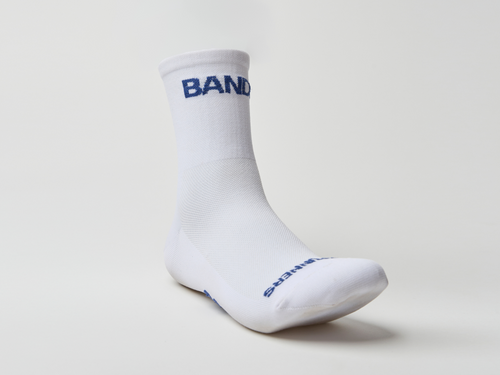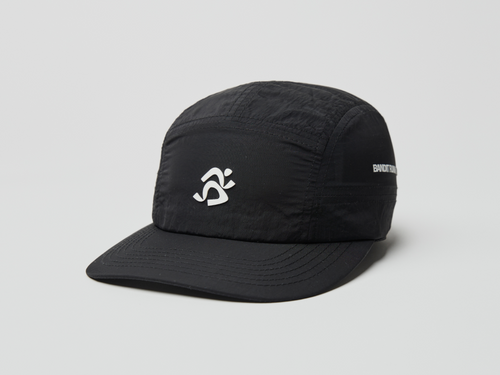Know Your Crew is our ongoing series documenting the crews and groups from around the world shaping the culture of running.
-
Koreatown Run Club (KRC) was founded in 2016 by Mike Pak and Duy Nguyen – two local leaders who define a certain scrappy and stylish altruism emblematic of their neighborhood’s entrepreneurial spirit, their own proclivities towards design and fashion and a desire to connect and support their community through the sport that they fell into by accident (more on that later).
Starting organically as a loosely planned group run as a way to bring members of their local community together, KRC has evolved into the rare example of a non-big brand entity in the running world that has found true cross cultural appeal – with profile in the likes of GQ, the LA Times and merch drops profiled in HypeBeast, the crew’s visual identity has both attracted new local runners to the sport and global fans appreciative of their ability to merge style and athletics.
Most importantly though, KRC is an example of success by way of placing the community-first - an example that should be celebrated as much as any brand collaboration or new shoe innovation.
In this edition of Know Your Crew, we spoke to Mike and Duy about everything from the origin of the club to how they’re pushing themselves to serve their community in new and unique ways:
Bandit: Did you know about Run Crews or Running Culture prior to founding KRC?
Duy Nguyen: Originally we didn't know anything about run crews. We weren't runners ourselves. We were just thinking 'how can we do something different for K-town?' Since our first love was soccer, we wanted to start a soccer club to play pickup.
I went to Mike and we put our heads together and tried to do it. But there was a lot of permitting and a lot of different issues that came up that made it pretty difficult and we kind of just put it on the back burner.
Red tape blocked the idea of a pickup soccer squad at the same time that Duy was about to experience the power of the sport of running.
DN: I went on a work trip to Haiti. I was shooting a documentary about these runners running across the country, doing 200 miles in seven days. They’re mostly just regular people. There were like two athletes - North Face runners, but everyone else was just regular people. They all ended up doing it, and I saw first-hand what could be accomplished in running and how it could bring people together. After that experience, I came back to Mike and I said, “Hey, let's do a running club.”

Bandit: What was the first run like for KRC?
DN: We just posted on Instagram - meet at this hotel in K-Town. We asked our friend who ran, like the one person who we knew who ran. It was like, Hey, can you make us a route? It was a totally random distance. When we finished, we came back, got food and hung out and said “Alright, what do we think? Is this a weekly thing? Is this a monthly thing?” And the group said, let's do it again next week. And we did it again next week.

The OG Instagram post from the inaugural run.
What started out as a running club with no plan or “blueprint” has no evolved into one of the most well-known running clubs in the world. Only 3 years after its inception, KRC now boasts hundreds of runners with a full on marathon training program called CAMP.
Bandit: Tell us more about CAMP…
DN: CAMP stands for "Community Assisted Marathon Program." In our second year, Mike and I, and like 13 other people were training for our first marathon - the LA marathon.
We had no idea what we were doing.. We were just basically running, adding two miles every Saturday for our long runs. That was the whole plan. But ultimately it worked, we got it done and the following year we had a lot more people that wanted to join the program.
The second time around, we did some googling and came up with somewhat more of a structure plan - not necessarily a good one, but it was a plan and it helped us a lot more.
Our third year was when it became more of an official thing. We started working more with coaches and Nike and a ton of other people in the community to make it an actual program. And at the same time, people wanted to help out because it was initially just Mike and I doing everything. Now it’s gotten to the point where we pretty much don't do anything {laughs}. But it was amazing to have a ton of community members raise their hand to say, “Hey, how can I help? Can I bring water? Can I do this and that?”
Our strategy has always been to ask those questions back to the community - What do you think? What do you want to do? People ended up waking up before the runners arrived, they got aid stations ready each with 3 to 4 people. They were all just self-starters, just wanting to do it for the good of the community.
KRC's CAMP program had runners ranging from 3:30 marathoners to 6 hour marathoners. The program's runners saw their work pay off - multiple first timers completed, with major improvements like multiple 6 hour marathoners cutting an hour off their time. When asked what their secret was, they attributed their improvements to the power of group training.
Bandit: As other crews across the country are looking to KRC as a role-model - do you have any suggestions as to how other crews and groups can replicate that magic?
DN: There wasn't a blueprint for anything. We didn't know that these crews, clubs, whatever groups of people that ran together even existed. We thought it was just, “running is a solo thing,”and I personally hated marathons because you’d have to wake up early in the morning for training… and just run. I didn’t get it. But the group aspect changed everything for me. And so when we did the program, we thought we were the first ones to do it. We just did it our way without knowing anything.
Mike Pak: It's hard to answer only because we're still trying to figure it out every day. There's always something new that challenges us that we just have to figure out on our own. Every day we're still learning and it's still so new to us especially given the growth of the group - a lot of new members to create a great experience for.
And we still get that feeling of like, “Oh shit, we just started basically all over again.” So, yeah, I think we’re still writing our own book and our own manual of how to do it.
Sometimes just knowing that those groups or people that you look up to are figuring it out as they go can give the confidence needed to create something of your own.
DN: I think the initial thing was, if we focus on the people and the community in the neighborhood, then everything else will come.
BANDIT: Community runs and CAMP are only a couple of the ways KRC supports their runners. One of the best manifestations of the KRC energy can be found in their cheer zone at the LA Marathon, called the “Bravo Zone.”
DN: It's a ton of people....maybe equivalent to like half a New York block. You're running for a good 20 seconds through Bravo Zone. Everyone is yelling at you, confetti is going off. You either love it, or you cramp up after because you get so hyped.

MP: I've been on the other side of the Bravo zone. As a runner you look forward to running through it. It's almost like the marathon equivalent of a NASCAR pitstop. To get oiled up, new shoes, and new socks. You look forward to that because it gives you that boost of energy to finish the race. It's like a huge bbq with friends and food. It's a huge party for runners who have been putting in the blood sweat and tears in training to finish this race. That added energy is really special to be around.

KRC's ability to provide for their community transcends running. Finding community needs and serving those needs is an integral part of their DNA.
Bandit: Tell us about one of your more recent community programs, Bicycle Meals.
MP: At the top of the pandemic, we asked ourselves how we could positively impact our community given everything going on. We got together to think through what we can start now that we can not only be consistent with, but keep it going for 5, 10, 15 years from now with the involvement of the community.
MP: We ultimately wanted to figure out how we could provide hot meals to our unhoused neighbors. We just wanted to be a part of our neighborhood and give back in some kind of way. It is a serious LA city problem, but our thinking was - if we can add a solution to a piece of the larger problem, little by little, there could be a ripple effect leading to a longer-term, positive impact on the bigger picture.
BANDIT: Is it every crew's responsibility to leave their community better than they found it? We say that run crews in general do just that by promoting running and enabling participation into the sport. But the larger question is posed: is it important for KRC to be a beacon of inspiration for other crews, groups and individuals?
MP: If you're part of the community and you really care about where you live and where you're from, I think that's something that you should not only have to do, but you should want to have that positive impact. We want to continue to do bigger things - having an effect on the kids, the youth. There's a gap in the community - a huge gang issue within our neighborhood as well. So we’re thinking through - how can we better serve these groups we care about, and how can we help people feel safe in our neighborhood.
Just talking about these things with friends and family - you can’t necessarily force anyone to serve the community, but just having that conversation shows people, “It’s possible that you can make a change like we’re striving to do with KRC.” So, why not make a bigger change within your community as well?
Why not?














